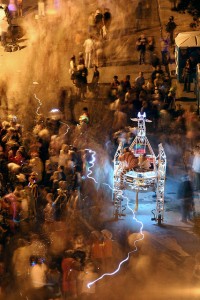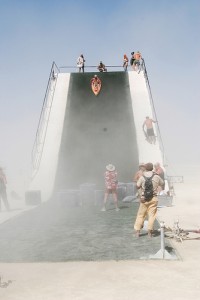This week is all about sex in my blog, so I knew I wanted to get some words from Kiki Christie, one of my favorite writers…
Category: Guest Bloggers
Guest post: Legitimizing Alternative Sexualities in Psychology by Emily Matthews
Posted in Guest Bloggers, Polyamory, and Sex & Relationships
I recently helped a member of my heart-family get help for severe depression. One of her fears was that her lifestyle choices would be rejected by…
Guest post: Radically Asking for Help
Posted in Burning Man, and Guest Bloggers
All this week I am sharing information and opinions about Burning Man, just in time for those who are going. After posting Gyesika Safety’s opinion about Radical…
A Burner Lexicon: Communal Effort
Posted in A Burner Lexicon, Burning Man, and Guest Bloggers

Communal Effort, Burners gather to spend a week or long weekend together living as freely as possible. Participation in theme camps, event infrastructure, and other shared activities forms strong social bonds that Burners are loath to relinquish when they return to the default world.
Communal Effort takes the connections made at a transient event and turns them into a full-time community. Burning Man itself maintains a network of regional contacts, and enclaves of anywhere from dozens to thousands of Burners have formed in almost every part of the world. In addition to regional events, parties, gatherings, and other social occasions are commonplace. Burners create businesses partnerships, relationships, and communal households together. Connections are maintained at a distance through use of Internet forums like EPlaya, and Burner groups are found on almost every social site from FetLife to LinkedIn. Some Burners have recently co-opted a phrase from the queer community: We Are Everywhere!
The gift economy itself contributes to community building because finding anything you need is a matter of knowing who and how to ask; the most involved Burners tend to become experts at social networking. Those who have accumulated enough whuffie through participation can call on their community for assistance with anything from finding housing to lifesaving supplies or funds in the aftermath of a personal disaster.
See also: Decompression, Church Night.
The lexicographer recently turned his experience as volunteer content editor for Burning Flipside into a paying gig in the default world, just one example of how communal effort has concrete results in Burner’s lives.
The lexicographer has been soliciting opinions from other thoughtful Burners on the Ten Principles. Below you will find another opinion, but more are still welcomed. Use the contact information at the top to send your thoughts.
If you’re going to That Thing in the Desert, remember to bring back catch phrases and slang for A Burner Lexicon (https://kitoconnell.com/lexicon/)!
A Burner Lexicon: Participation
Posted in A Burner Lexicon, Burning Man, and Guest Bloggers

Participation, Our culture encourages consumption of passive entertainment. Even when we escape the home, we attend events where everything is guided for us — we are either audience or performer, spectator or creator. We pay money to passively watch music events, theater, movies, and so on, always knowing the limits of our role. At other festivals, paid entertainers play while others consume, not only limiting the creativity of most attendees but also setting a value on involvement, whereby some people are ‘official’ or ‘professional’ and others strictly amateur.
When speaking of an attendee of an event in the Burn community, one does not refer to a visitor, ticket holder, viewer, audience or spectator but of a Participant. A Burn is part concert, part dance party, part fashion show, and part art gallery but these things happen because of the efforts of those who attend. A Burner fashion show typically consists not of outside models, but of individual Burners showing off their finest outfits, often acquired freely through the gift economy. Though there are art grants, they often require addirtional fundraising by artists and the creations themselves are often participatory, encouraging viewers to push buttons, turn levers, write, draw or otherwise interact. Musicians perform not because they are paid, but because they made their own way to the event (or were paid to come by the fundraising efforts of other participants).
Though That Thing in the Desert has a limited number of year-round, paid employees, all events are almost entirely run by volunteer labor. Though the BMORG (or its local equivalent) may deal with the hurdles of ticketing and permitting, it is participants who build the temporary city, from its airport and post office to its nightclubs and pancake camps. Participation breaks through the filters that keep people separate and plunges the one into the many and the immediacy of the experience. Participants look at Burn events as a chance to push boundaries, try new things, and expand personal horizons through experience.
Greeters often ask new arrivals what they plan to give; No Spectators is one of the community’s rallying cries. Many have experienced the rush of looking around at the wild debauchery of Burn Night and realizing they helped create that moment through their hard work. Some can afford to volunteer year-round for their community, others give much less. The Burnier-than-thou often judge other Burners on the degree of their involvement, overlooking the many kinds of participation — a concert is just a private jam session without an audience and a DJ is pointless without people to listen or dance.
Virgins are often discouraged from volunteering too heavily for many reasons, but one is the important lesson it teaches in the myriad ways we can give — at the lexicographer’s first Burn, he felt as though he was not contributing enough until he realized the true value of cooking a hot, filling meal for his more involved campmates.
The Lexicographer has been soliciting opinions from other thoughtful Burners on the Ten Principles. Below you will find two opinions, but more are still welcomed. Use the contact information at the top to send yours.
For more entries in A Burner Lexicon, visit https://kitoconnell.com/lexicon/
A Burner Lexicon: Decommodification
Posted in A Burner Lexicon, Burning Man, and Guest Bloggers

Decommodification, Our lives can feel fully commercialized — advertising surrounds us, from logos on the clothing we wear to advertisements so pervasive they even appear in bathroom stalls. Not only do people take part in a commercialized world, they sometimes even craft their identity from their shopping choices (Android vs. iPhone, anyone?). People are even encouraged to market their “personal brand.”
Subcultures and counterculture are especially susceptible to being co-opted and commercialized as marketers and coolhunters look for the latest youth trends to capitalize on in a process that has gone on since well before the 1960’s — according to the book Counterculture Through the Ages by R. U. Sirius and Dan Joy, the automotive industry borrowed the term “tripping out” for use in ad copy as early as 1967. Though commercialization does not necessarily destroy subcultures, it can interfere with participants’ ability to experience them with complete immediacy.
Thus far, the Burning Man community has largely resisted commercialization through a dedication to the principle of decommodification, a dedication that it acts on through both social and legal means. Socially, Burners work to hide logos on rented trucks and enforce the commerce free, gift economy nature of their event through education and peer pressure. Legally, the BMORG (and similar regional organizers) enforce decommodification by carefully policing the use of logo, name, and even photos from the events. This has included successful lawsuits against groups like Girls Gone Wild, who would have exploited female participants for profit. Ideally, Burners use this increased awareness to make more knowing choices when they return to the commercially saturated default world.
In 2007 the BMORG made the controversial decision to allow certain environmental organizations to display their products in a special pavilion near the effigy as part of that year’s Green Man theme. It was that same year that Paul Addis made an even more controversial attempt to burn the effigy early, at least partly in protest to the weight given to this corporate logo, an act for which he was charged with felony arson.
The Lexicographer has been soliciting opinions from other thoughtful Burners on the Ten Principles. Below you will find another opinion, but more are still welcomed. Use the contact information at the top to send your thoughts.
For more entries in A Burner Lexicon, visit https://kitoconnell.com/lexicon/

